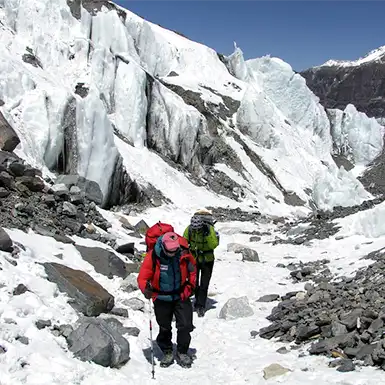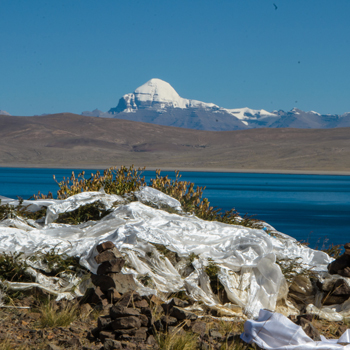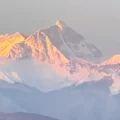Imagine a place where majestic mountains blend seamlessly with the tranquility of Buddhist practice. Rongbuk Monastery, perched at an astounding 5,009 meters (16,434 feet), offers just that. It is situated near the north face of Mount Everest in Tibet, making it the highest monastery on earth. Thus, one of the best places to submerge yourself in Tibetan culture and ancestral rites is Rongbuk, against the background of the most impressive peak on the planet.
Rongbuk Monastery is a geographical marvel and a vibrant center of Tibetan Buddhism. The Nyingma Lama Ngawang Tenzin Norbu established the monastery in 1902, giving it a rich historical background. It served as a refuge and source of support for early climbers attempting the treacherous ascent of Everest, including those once considered “heretics.” A tradition emerged where climbers would pay their respects at the monastery before starting their expeditions.
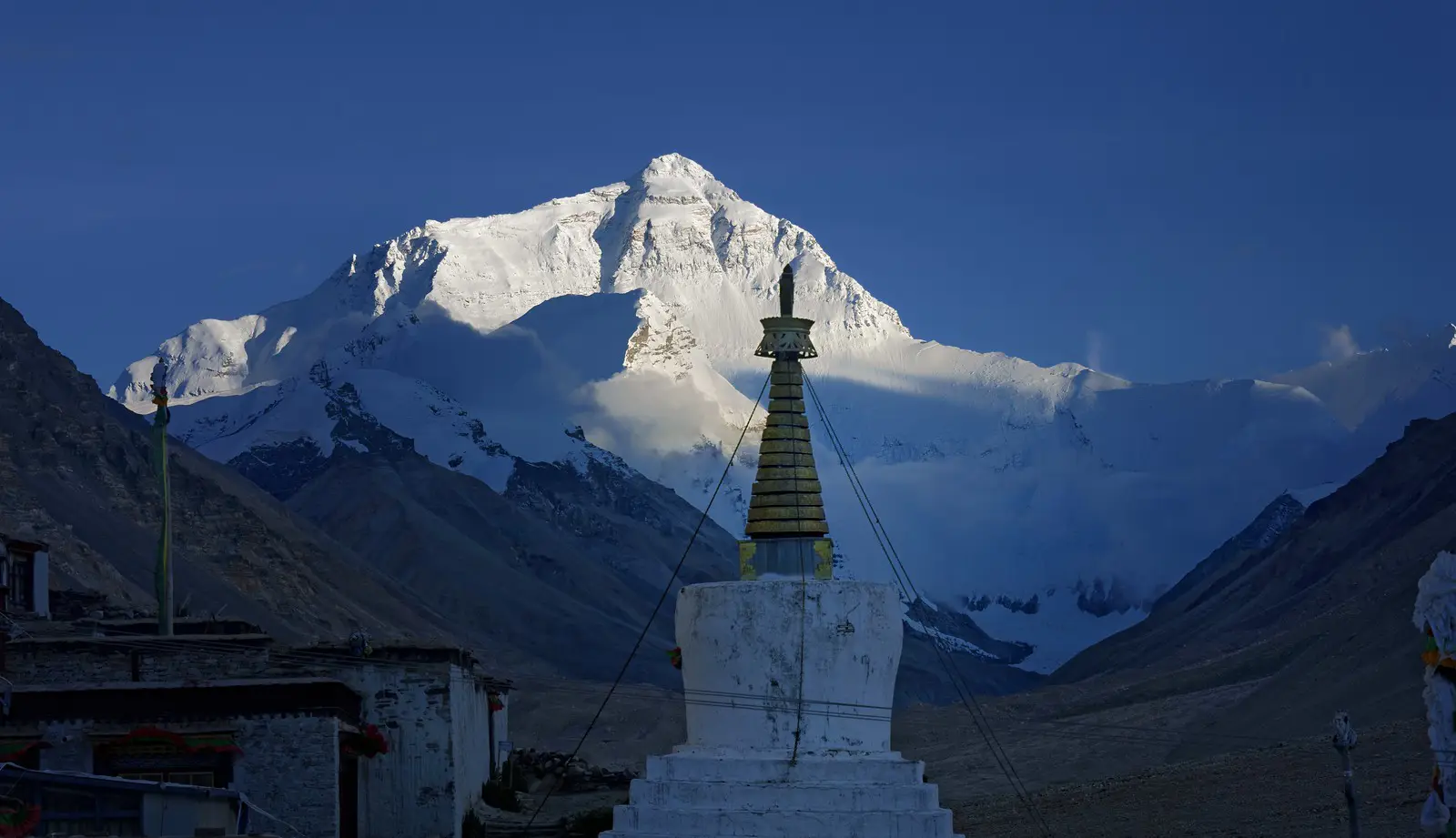
A Glimpse into History: The Founding and Evolution of Rongbuk Monastery
Rongbuk Monastery’s story stretches back over a century, intricately woven into the rich tapestry of Tibetan Buddhism. The revered Nyingma Lama Ngawang Tenzin Norbu founded the monastery in 1902, building it on ground already rich with history. The location held significance for centuries before, serving as a retreat for hermits and nuns who utilized meditation caves nestled in the surrounding cliffs. Here are some key points to grasp the historical context of Rongbuk:
- Nyingma Lineage: The monastery belongs to the Nyingma sect, the oldest tradition of Tibetan Buddhism known for its emphasis on meditation practices and tantric teachings.
- Spiritual Sanctuary: The area was already a renowned spiritual sanctuary before its formal establishment. Meditation caves dotting the landscape demonstrate the long-standing tradition of seeking spiritual refuge in this particular location.
- Founding Lama: The visionary Ngawang Tenzin Norbu, also known as Zatul Rinpoche, played a pivotal role. He established the monastery, attracting hundreds of monks and pilgrims who flocked to the site for teachings and religious ceremonies.
- Connection to Local Community: Rongbuk Monastery wasn’t just a place of worship but a vital center for the local community. Here, pilgrims would gather for annual ceremonies while monks provided religious guidance and education.
The monastery’s history, however, has been challenging. It suffered significant damage during China’s Cultural Revolution (1966-1976). Thankfully, after this tumultuous period, restoration efforts began, and the monastery continued to function as an important religious center.
Soaring High: The Geographical and Cultural Significance of Rongbuk Monastery
Rongbuk Monastery’s geographical significance is undeniable. Its location at the foot of Mount Everest, the earth’s highest peak, is extraordinary. The monastery, nestled at an altitude of 5,009 meters (16,434 feet), stands amidst the stark beauty of the Himalayas, dwarfed by the majestic presence of Everest. This unique setting shapes the very essence of Rongbuk. The proximity to Everest isn’t just a geographical fact; it profoundly influences the monastery’s cultural and spiritual Life. Here’s how:
- A Landscape Steeped in Symbolism: Mount Everest, known as Chomolungma (“Goddess Mother of the World”) in Tibetan, holds immense spiritual significance. People revere the colossal peak as a dwelling place of deities. The location of Rongbuk Monastery strengthens the connection between the natural world and the divine.
- A Testing Ground for Faith: Reaching Rongbuk is challenging, requiring a strong spirit and acclimatization. This trip reflects the Buddhist concept of overcoming obstacles on the path to enlightenment. The Dalai Lama himself has stated, “Peace does not come from outside. We must develop Peace from within.” The very act of reaching the monastery becomes a testament to a pilgrim’s dedication.
- A Sanctuary for Climbers: It serves as a base camp for many Mount Everest expeditions. Climbers, facing immense physical and mental challenges, often seek blessings and a moment of Peace at the monastery before their ascent. The monastery’s presence offers a sense of solace and spiritual grounding amidst the harsh realities of climbing the world’s most formidable mountain.
A Glimpse into the Monastery Walls: Rongbuk’s Architectural Grandeur
Rongbuk Monastery isn’t just a spiritual sanctuary and a treasure trove of Tibetan Buddhist art and architecture. Adapted to the harsh Himalayan environment, the monastery is a collection of low-rise buildings constructed from stone and wood, with walls painted in a vibrant red color. Here are some key architectural features that distinguish Rongbuk:
- Traditional Design: The monastery adheres to traditional Tibetan architectural principles, featuring flat roofs and inward-sloping walls to withstand the strong winds.
- Prayer Wheels: Countless prayer wheels, a hallmark of Tibetan Buddhist practice, dot the monastery grounds. Pilgrians spin these wheels while chanting mantras, accumulating merit, and sending out prayers.
- Thangka Paintings: Inside the monastery’s halls, visitors can find exquisite thangka paintings – vibrantly colored cloth scrolls depicting Buddhist deities, mandalas, and spiritual scenes. These intricate artworks serve as visual aids for meditation and inspire reverence among devotees.
- Status: The monastery houses several statues, including imposing figures of Buddha and other important figures in Tibetan Buddhism. These statues aren’t merely decorative; they serve as objects of focus for prayer and meditation.
It has undergone restorations throughout its history. Following the destruction during China’s Cultural Revolution, authorities undertook significant efforts to rebuild and preserve the monastery’s architectural heritage. These restorations ensured the continuation of this unique artistic tradition and allowed visitors to experience the beauty and significance of Tibetan Buddhist art.
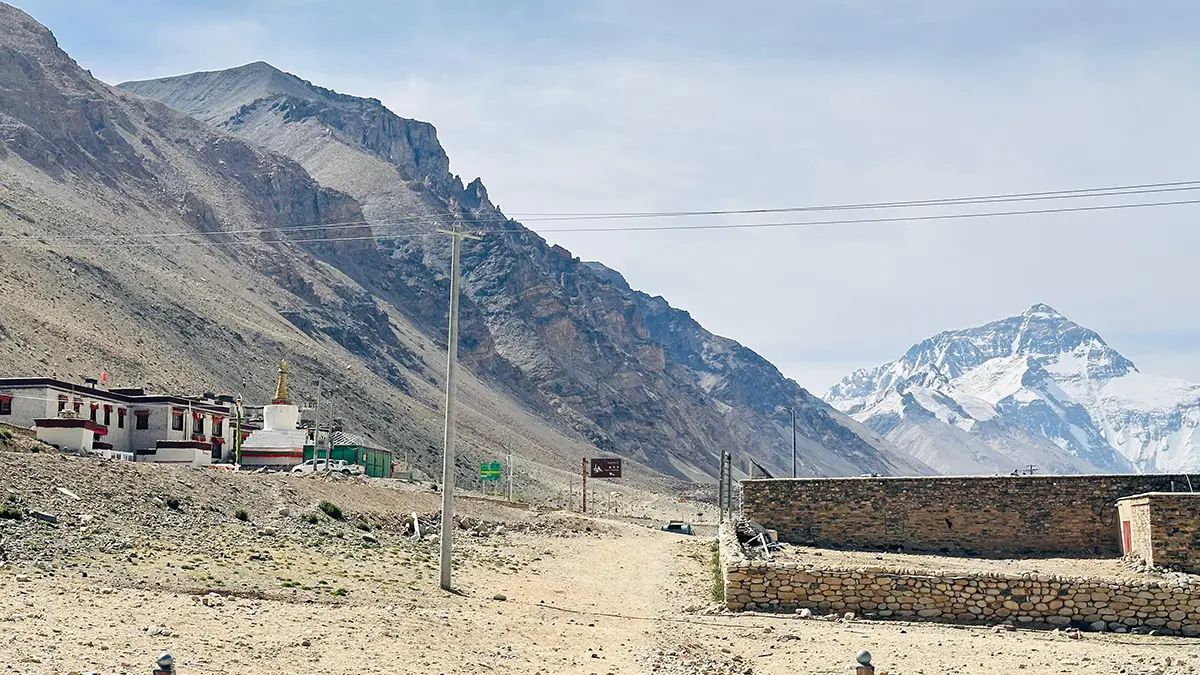
A Life of Devotion: Religious Practices and Festivals at Rongbuk Monastery
The Monastery Rongbuk is filled with a pulsating rhythm of daily routines and exciting yearly ceremonies. Here, men and women spend their time in prayer and meditation to uphold their Buddhist beliefs. Tourists can get a feel for it here so that they will understand Tibetan Buddhist traditions.
Daily Practices
- Morning and Evening Prayers: The day at Rongbuk begins and ends with communal prayers in the Grand Hall. Monks chant mantras, accompanied by the rhythmic sounds of drums and cymbals.
- Meditation is essential among practicing Buddhists. During the day, monks and nuns meditate to achieve stillness and clearly perceive the nature of things.
- Puja Ceremonies: Throughout the day, people make offerings and prayers in smaller ceremonies called pujas. They can dedicate these pujas to specific deities or the well-being of themselves or their loved ones.
Annual Festivals
- Mani Rimdu Festival: Rongbuk Monastery’s most significant celebration is this colorful festival, observed in late October or early November. It is held annually to commemorate the teachings and Life of Guru Padmasambhava, who brought Buddhism to Tibet. Participants perform masked dances, display vibrant thangkas, and engage in lively chanting.
- Saga Dawa Duchen: Remember the full moon in the Tibetan quarter. This festival commemorates Gautama Buddha’s birth, enlightenment, and Parinirvana (death). Pilgrims gather at Monastery Rongbuk to participate in special prayers and ceremonies.
Spiritual Figures and Lore
- Nyingma Lama Ngawang Tenzin Norbu: As mentioned earlier, this revered Lama founded Rongbuk Monastery in 1902. His recognition of the area’s spiritual significance led to the establishment of this vital center for Buddhist practice.
- The Dalai Lama: While not directly associated with Monastery Rongbuk, the Dalai Lama, the spiritual leader of Tibetan Buddhism, is a powerful symbol of Peace and compassion. His teachings, which emphasize inner Peace and universal responsibility, resonate deeply with the practices observed at the monastery. The Dalai Lama himself has said, “Happiness is not something readymade. It comes from your actions.” The monks and nuns at Rongbuk Monastery embody this philosophy. They dedicate themselves to their faith and pursue enlightenment.
Planning Your Pilgrimage: A Visitor’s Guide to Rongbuk Monastery
Rongbuk Monastery, nestled in the majestic Himalayas, attracts both adventurous travelers and spiritual seekers. Before starting this extraordinary trip, here is some practical advice to ensure a smooth and enriching visit:
Best Time to Visit
- Spring (April-May) and Autumn (September-October): These shoulder seasons offer pleasant weather with clear skies, ideal for witnessing the grandeur of Everest and enjoying outdoor activities.
- Summer (June-August): While the weather can be unpredictable, this is the peak tourist season with occasional monsoon showers. Be prepared for crowds.
- Winter (November-March): The monastery remains open, but frigid temperatures and high winds can be challenging. Rongbuk is best visited during spring and autumn when the weather is more forgiving.
Accommodation
Due to Rongbuk Monastery’s high altitude, most visitors stay briefly at the site. The thin air and stark conditions pose challenges for extended stays, even for the most resilient travelers. As a result, many opt for day trips to the monastery, soaking in its serene atmosphere and stunning views before heading back to lower, more comfortable altitudes.
Those wishing to prolong their visit to the area will find more accommodating lodgings in nearby towns like Shegar and Old Tingri. Guesthouses and lodges in these towns offer essential amenities for relaxation and healing following a day of exploration. During peak tourist seasons, you should book these lodgings in advance to eliminate last-minute inconveniences and ensure availability.
Travel Tips
- Acclimatization is Crucial: Rongbuk sits at a staggering altitude. Allow ample time for acclimatization in lower areas before ascending to minimize the risk of altitude sickness.
- Permits: Foreign visitors need special permits to enter Tibet, which they typically obtain through a travel agency specializing in Tibet tours.
- Respectful Behavior: Remember, it is a functioning religious center. Dress modestly, speak softly, and be mindful of ongoing religious practices.
- Prepare for the Elements: The weather in the Himalayas can change rapidly, so pack layers of clothing, sunscreen, sunglasses, and a hat. Strong winds are common, so bring a sturdy scarf to secure your belongings.
Impact of Tourism
Tourism plays a vital role in our local economy, which is why many Tibetans rely on it as a source of income. However, we must be cautious due to possible disadvantages. An excessive number of tourists may lead to resource depletion and disturb the Peace at the monastery. Responsible tourism is critical when choosing the right tour company that embraces sustainable methods while upholding our cultures. Be mindful of waste disposal and avoid littering in the pristine Himalayan environment.
Safeguarding a Sacred Sanctuary: Conservation Efforts at Rongbuk Monastery
Rongbuk Monastery’s remote location and harsh environment present unique challenges for its preservation. The monastery and its surrounding ecosystem require ongoing conservation efforts.
Challenges and Considerations
- High Altitude and Harsh Climate: The extreme altitude and frigid temperatures constantly threaten the structural integrity of the monastery buildings. Preserving the traditional materials used in construction, like mudbrick, requires specialized techniques and ongoing maintenance.
- Waste Management: With increased tourism comes the challenge of waste management. The delicate Himalayan environment is particularly susceptible to pollution. Implementing sustainable waste disposal systems and educating visitors on responsible practices are crucial.
- Water Scarcity: Due to climate change, there is concern that the Himalayas may soon run out of water. For its water supply, Rongbuk depends on water from melting glaciers. Conservation efforts focus on water harvesting techniques and minimizing water usage.
Collaboration for a Sustainable Future
While the challenges are significant, Rongbuk Monastery isn’t alone in its conservation efforts. Here are some positive developments:
- Local Initiatives: The Tibetan government has implemented several programs to promote sustainable tourism practices and support local communities in protecting their environment.
- International Collaboration: Conservation organizations are working with local authorities to develop strategies for preserving the unique ecosystem surrounding the monastery.
- Monastery’s Role: The monks themselves play a vital role in conservation. Their respect for the natural world is consistent with the Buddhist principles of compassion and non-harm. Rongbuk can serve as a model for sustainable practices in the region.
A Legacy Enduring: Rongbuk Monastery in the Modern World
Rongbuk Monastery stands today as a testament to the enduring spirit of Tibetan Buddhism. While centuries old, the monastery continues to evolve, adapting to the realities of the modern world while staying true to its core traditions.
A Thriving Spiritual Center
- Monastic Life Continues: Despite facing challenges in the past, Monastery Rongbuk remains an active center for monastic Life. A dedicated community of monks and nuns resides at the monastery, upholding daily prayer, meditation, and scripture study practices.
- Pilgrimage Destination: Rongbuk remains a major pilgrimage destination for Buddhists from Tibet and beyond. Visitors gather at the monastery to seek blessings, join religious ceremonies, and connect with their faith.
- Community Outreach: The monastery also plays a role in the surrounding community. Monks often teach or bless residents, nurturing a sense of spiritual connection and cultural identity.
Balancing Tradition and Modernity
- Sustainable Practices: As discussed earlier, it is actively involved in conservation efforts. It demonstrates an embrace of modern practices like sustainable waste management while preserving the sacred natural environment.
- Accessibility and Technology: The presence of guesthouses and basic amenities near the monastery acknowledges the needs of modern travelers. However, these developments are implemented with care, ensuring they don’t disrupt the tranquility of the spiritual sanctuary.
Conclusion: A Beacon of Spirituality at the Foot of Everest
Rongbuk Monastery transcends its status as the world’s highest monastery. It’s a vibrant center of Tibetan Buddhist practice and culture, where ancient traditions co-exist with breathtaking Himalayan beauty.
More Than Just an Everest Base Camp Stop
- For trekkers attempting Mount Everest, Rongbuk is a convenient stop along the way. However, the monastery offers a far richer experience. It’s a chance to:
- You will see how observant monks and nuns are when they do daily prayers and rituals.
- Experience the vibrant atmosphere of Tibetan Buddhist festivals, filled with colorful displays and joyous chanting.
- Reflect on the profound teachings of Buddhism, finding a sense of inner Peace amidst the majestic Himalayas.
- The Dalai Lama himself said: “Peace is not something you can take for granted; it’s a product of your actions.” In line with that, Rongbuk vividly illustrates the saying. It’s a place where visitors can witness the pursuit of Peace and enlightenment firsthand.
A Living Legacy of Tibetan Buddhism
Rongbuk Monastery isn’t just a relic of the past; it’s a vibrant community that upholds sustainable practices while preserving centuries-old traditions. Visiting here provides a unique opportunity to:
- Connect with a rich cultural heritage and gain a deeper appreciation for Tibetan Buddhism.
- Admire the dramatic Himalayan scenery, acknowledging the profound connection between the natural world and spiritual beliefs.
- Help preserve this sacred place by practicing responsible tourism and respecting the local culture.

